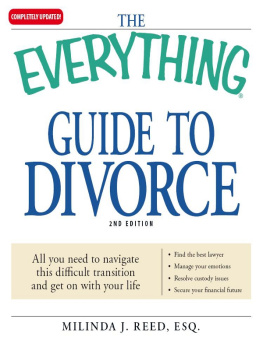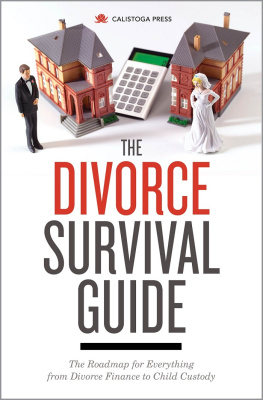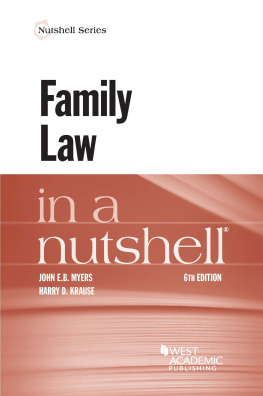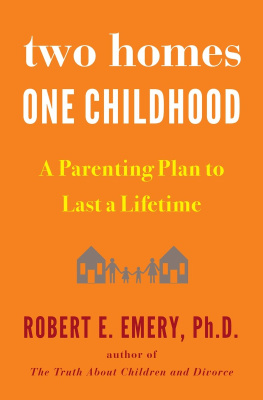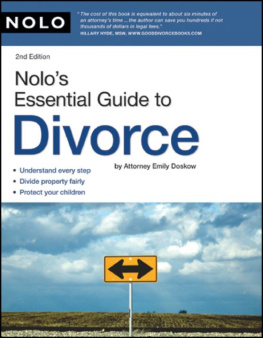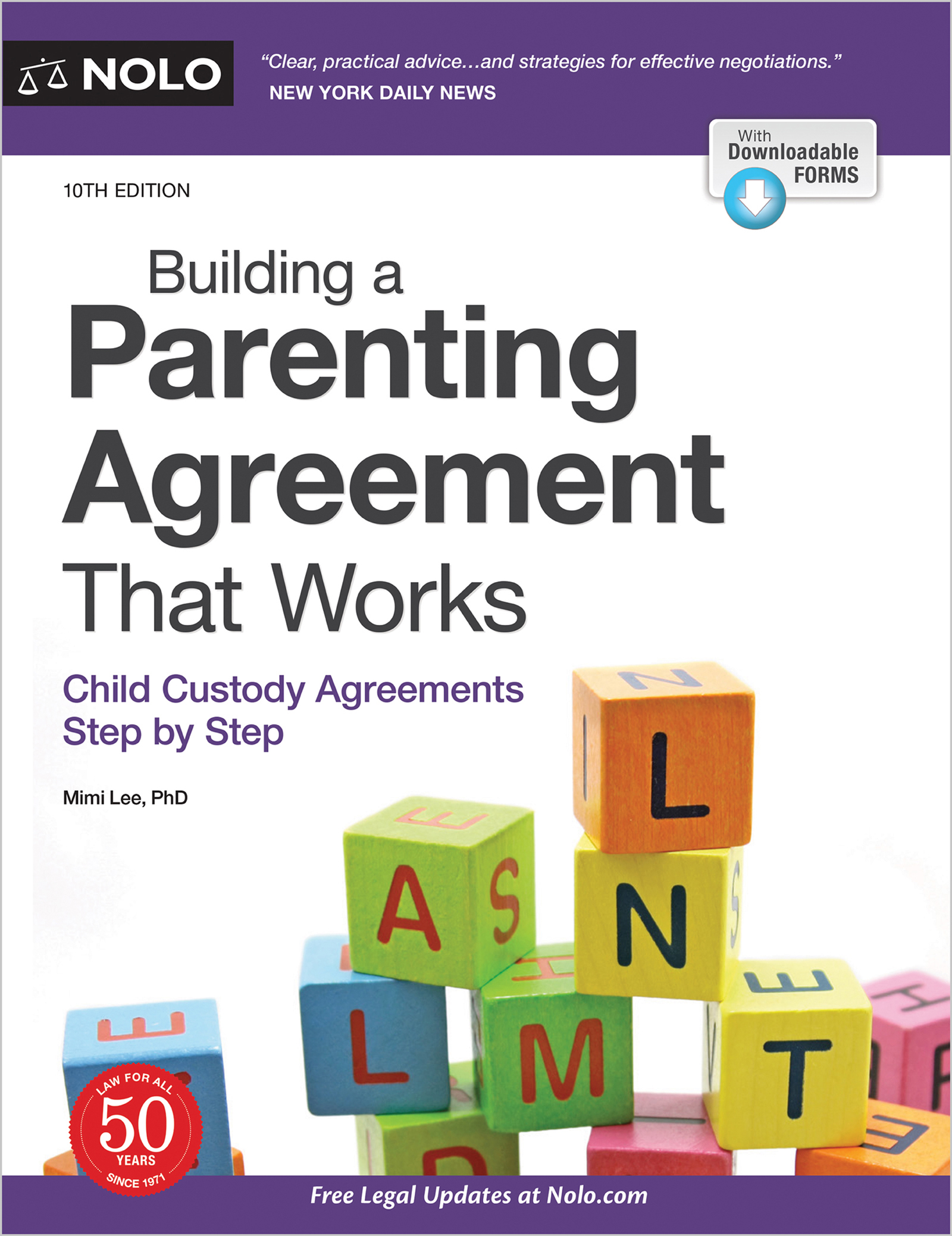Contents
Guide
Pagebreaks of the Print Version
10th Edition
Building a Parenting Agreement That Works
Child Custody Agreements Step by Step
Mimi Lee, PhD

| TENTH EDITION | SEPTEMBER 2022 |
| Editor | STACY BARRETT |
| Cover Design | SUSAN PUTNEY |
| Production | SUSAN PUTNEY |
| Proofreader | JOCELYN TRUITT |
| Index | ACCESS POINTS INDEXING |
| Printing | SHERIDAN |
ISSN: 2832-210X (print)
ISSN: 2832-2126 (online)
ISBN: 978-1-4133-3011-3 (pbk)
ISBN: 978-1-4133-3012-0 (ebook)
This book covers only United States law, unless it specifically states otherwise.
Copyright 1995, 1996, 1999, 2003, 2005, 2007, 2010, 2014, 2018 by Mimi Lyster Zemmelman. Copyright 2022 by Mimi Lee.
All rights reserved. The NOLO trademark is registered in the U.S. Patent and Trademark Office. Printed in the U.S.A.
No part of this publication may be reproduced, stored in a retrieval system, or transmitted in any form or by any means, electronic, mechanical, photocopying, recording, or otherwise without prior written permission. Reproduction prohibitions do not apply to the forms contained in this product when reproduced for personal use. For information on bulk purchases or corporate premium sales, please contact .
Please note
Accurate, plain-English legal information can help you solve many of your own legal problems. But this text is not a substitute for personalized advice from a knowledgeable lawyer. If you want the help of a trained professionaland well always point out situations in which we think thats a good ideaconsult an attorney licensed to practice in your state.
Dedication
This edition of my book is dedicated to the extraordinary partnership that ushered it into imagination and then into being. I continue to thank and honor Kevin Elkus, my brother; Steve Elias, my first editor; and John Heliefriend and mentor extraordinaire. It is also dedicated to the children, and now grandchildren, who have graced my life.
About the Author
Mimi Lee has worked extensively with individuals and organizations to interrupt conflict, open productive dialogue, and make the decisions needed to achieve their goals. She maintains both an organizational consulting and a mediation practice in the San Francisco Bay Area. Her approach to helping organizations get where they want to go is similar to the way she helps parents build agreements that put their childrens needs first. The first step is to create a safe space within which we can talk and work together. The rest typically unfolds naturally from there.
Table of Contents
Introduction
This is a book for parentsseparating or separated, divorcing or divorcedwho are looking for ways to parent well. It doesnt offer easy fixes. Instead, it provides time-tested strategies that other parents have relied on to create child-centered agreements about how they will share and divide their parenting responsibilities.
Whether the separation or divorce was your idea or not, youre heading toward some difficult conversations. This book can help you and the other parent learn ways to keep your focus on meeting your childrens needs and promoting their best interests. Most parents can find an approach that suits their needs from the options provided in each of the sections of the book.
And if you cant find an approach that fits your needs, you will find information that can help you think about ways to create a solution that makes more sense for you, the other parent, and your children. Because its divided into sections, this book can help you draft your first agreement and adjust it later once things have settled downor when your lives, or your childrens needs, change.
This type of agreement can have many names. Most commonly, its called a child custody or child custody and visitation agreement. Because these agreements cover much broader issues than custody and visitation, we refer to them as parenting agreements and parenting plans in this book. Whatever label you (or your states courts) use, parenting plans usually cover:
- where the children will live
- how you and the other parent will make necessary decisions about your children
- how the children will spend time with each of their parents and any other people who are important to them, and
- how the childrens medical, emotional, educational, spiritual, physical, and social needs will be met.
Take some time with this process. These are important issues. So are the needs, worries, and wishes that you, the other parent, and your children bring to this process.
Keep in mind that separating and divorcing parents are not entirely alone in deciding these issues. Each state has laws to protect childrens needs when parents split up. Courts use these laws to decide custody and other issues when parents cannot agreeor are fighting abouthow a child will be raised or cared for.
While its possible to negotiate your own parenting plan and not have it turned into a court orderthis approach is very rare, because it cannot be enforced. In fact, courts place such a high priority on having enforceable agreements, that there are almost no situations where people with children have gotten legally separated or divorced without a child custody order as well. Courts tend to be very concerned about having clear child custody orders in place if you and the other parent disagree about where your children should live or how decisions should be made on their behalf.
The most important piece of the puzzle here is your ability to work together with the other parent and potentially the court to develop a thoughtful plan. If you can get there, the agreement can become a cornerstone for resolving other aspects of the separation or divorce, and allow you and the other parent to move on with your lives.
Make Your Own Custody Decisions If Possible
When parents first think about custody and parenting issues, they are often in the middle of a separation or divorce. It can be difficult to keep hurt and angry feelings about the other parent from affecting their decisions about their childrens future. Often a parents first instinct is to demand full custody of the children. All too often the other parent responds in kind. These instinctive responses only add to the cost and pain of a divorce. The end result typically benefits no one and can make the process more painful for everyone involved, especially the children.
When parents leave parenting issues to the court rather than resolving them on their own, they shortchange themselves. Once these issues go to court, parents are forced to rely on a judge or court-appointed specialist to understand the familys situation and make good decisionsoften after only meeting with the family for a few minutes or hours. Its very difficult for a judge to make the right decisions for your children under these conditions.
Each state has guidelines for its judges to follow when making custody decisions. Nonetheless, judges have considerable discretion to interpret these guidelines and impose their own views about what constitutes a good environment for children. The chance that a judges decision, informed at only the most superficial levels, will be ideal for your specific situation is relatively slim.



